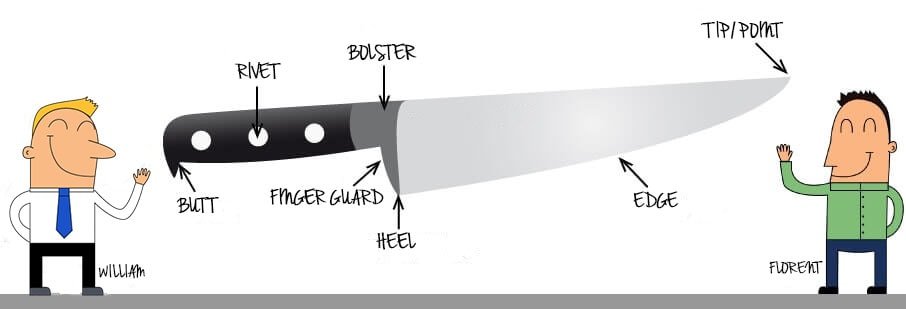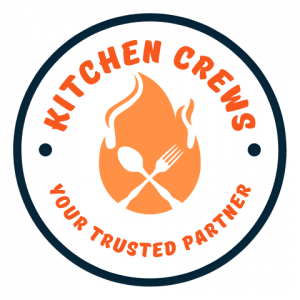The humble kitchen knife may seem simple, just a blade and handle coming together to slice and dice. But while the concept is straightforward, properly crafted knives are complex tools made up of various specialized parts working in harmony. The edge aligns with the spine to facilitate cutting, while the handle and butt provide control and leverage. Components like the bolster and heel contribute heft and balance.
Even aesthetic embellishments offer functionality. Each part plays a role in how a chef’s knife performs, whether it’s surgically dismantling a chicken or precisely mincing an onion. Understanding the nuances of these fundamental knife components allows you to select optimal cutting tools for comfort and efficiency in the kitchen.
Here are the main parts of a kitchen knife:
- Blade
- Edge
- Point
- Bolster
- Heel
- Spine
- Handle
- Butt/End cap
Main parts of a kitchen knife and their Function
Blade
The blade is the long metal piece that makes up the body of the knife. It stretches from the handle to the tip, including the cutting edge. The material, shape, grind, finish, and flexibility of the blade all contribute to how the knife performs. Quality blades are made from high-carbon steel alloys that take and hold an edge very well.
- Cuts through food
- Usually 3-8 inches long
- Made of various steels with different properties
- Shapes affect use ( curved/straight)
Edge
The edge is the part of the blade that is ground to a bevel to create a sharp cutting surface. It will either be a plain or serrated design. The angle of the edge bevel, symmetry of the sides, and sharpness determine efficiency and ease of cutting. Maintaining a properly sharpened edge is essential for optimal knife function.
- Does the actual cutting
- It can be straight, serrated, Granton, etc.
- Needs regular sharpening
- The angle varies by purpose

Point
The point is the tapered end of the blade tip used for more detailed tasks like deveining shrimp or slicing shallots. The shape, thickness, and sharpness of the point provide more or less control for intricate cutting, piercing, or carving.
- Allows detail and precision cutting
- Pierces easily through foods
- It can be blunted for safety
- Comes in various tip shapes
Bolster
The bolster is a thick piece of metal where the handle meets the blade. This provides counterbalance by weighting the end of the knife. It also protects the hand from slipping onto the blade. However, full bolsters can interfere with sharpening the heel of the blade.
- Provides balance and heft
- Can have an embellished look
- Creates transition from blade to handle
- Protects the hand from sliding up
Heel
The heel refers to the rear end of the blade closest to the handle. It provides leverage and adds weight when chopping. Using the heel helps protect the fine edge from damage during hard cuts through things like bone. The curve, thickness, height and shape of the heel contribute to the knife’s balance.
- Adds balance towards rear of the blade
- Provides chopping leverage
- Prevents edge damage on hard foods
- Varies in height and shape
Spine
The spine is the typically thicker and blunt top side of the blade opposite to the cutting edge. It runs the length of the blade to reinforce the shape. Spines can be completely dull or have embellishments like texture for grip or holes for aesthetic appeal. Keeping the spine dull protects fingers from being cut when pinching higher up the blade.
- Provides strength and stability
- Usually left unsharpened for safety
- It can have decorative texturing or holes
- Transitions into taper near point
Handle
The handle covers part of the tang or blade base to provide grip. Standard kitchen knife handles are made of materials like plastic, wood, or rubber. The shape, size, and surface finish help determine comfort and control. Well-designed handles allow proper hand placement for natural movement and leverage.
- Provides a safe and comfortable grip
- Made of various durable materials
- Properly balanced for using knife safely
- Can have finger guard for protection
Butt/End Cap
The butt or end cap is the bottom end of the handle. It is often capped with an additional decorative material. Exposed tang handles will have the tang flattened or rounded into a butt. The butt provides necessary leverage and force on the bottom end of cuts when gripping the handle.
- A flat surface improves grip and chop pressure
- Sometimes decorative colored plastic, metal
- Shapes handle base and finish
FAQ
Here are some common FAQs about kitchen knife parts.
Are the bolster and heel the same thing?
No. The bolster is a thick piece of metal separating the handle and the base of the blade, mainly for balance. The heel refers to the rear lower section of the blade near the bolster, used for heavy chopping and preventing edge damage.
Is the tang of a knife the spine?
No. The tang is the extension of the blade metal that stretches into the handle for support and balance. The spine is the typically dull, thicker top side that runs the same length as the sharpened edge.
What is the proper name for the knife handle end?
The bottom of the handle is referred to as the butt or end cap. The exposed tang may be shaped into a flattened butt if there is no end cap material.
Do knife point and tip mean the same thing?
Yes. Both point and tip indicate the end section of the blade used for detail work and tip cuts.
What’s the difference between an edge and a bevel?
The edge refers specifically to the sharpened side that does the cutting work. The bevel is the angled flat surface ground into the blade behind the edge to create this sharp edge.
Final Thoughts
So, in conclusion, while a kitchen knife may seem as simple as metal meets handle, it is an intricately designed tool. The various components work synergistically to produce ideal balance, control, and cutting functionality.
From the curve of the bolster to the angle of the edge bevel, every part has a specific purpose, with great thought given even to embellishments for aesthetic flair. Appreciating how these pieces seamlessly work together provides insight into selecting knives that feel like natural extensions of your hand for achieving kitchen brilliance.
Related Post:
Recent Posts
All-purpose chef's knives, cook's knives, and other kitchen knives used daily for meal prepping fill overlapping roles of slicing, dicing, and chopping ingredients. However, the precise differences...
Bread knives have prongs to prevent the bread's soft interior from compressing downwards when sliced. As the knife presses down, the prongs allow pockets of air to escape sideways instead of getting...
